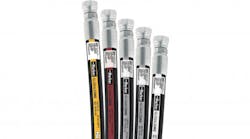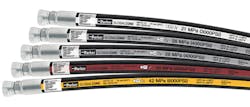The wide variety of hydraulic hose constructions on the market can make selection confusing for both initial specification and aftermarket replacement. (Actually, if an application needs special consideration — such as high abrasion resistance or survival in a hostile chemical environment — the choice may be simpler due to fewer options.) Add all of the possible fittings to the component equation and many more products will become available.
This file type includes high resolution graphics and schematics when applicable.
For general industrial hydraulic applications, Parker Hannifin’s Hose Products Div., Wickliffe, Ohio, has developed GlobalCore to simplify conductor selection. GlobalCore – a series of five types of hydraulic hose and two series of fittings that match them all – significantly reduces engineering and service complexity by providing a comprehensive product family that covers the most commonly used constant-working-pressure classes in industry.
GlobalCore products are built and tested to twice the ISO 18752 specification and provide options that match the most critical pressure ranges and sizes: 3,000 to 6,000 psi, in sizes -4 through -32 (1/4 to 2 in.). Available no-skive covers include standard rubber or two grades of higher abrasion resistance. Synthetic rubber inner tubes are compatible with a wide range of fluids. Fittings are simply chosen to match the hose type selected and the working pressure of the system.
The GlobalCore hose design enables it to be bent to half the bend radius of conventional hose. It also requires less force to flex. With such a combination, installation and routing become significantly easier.



